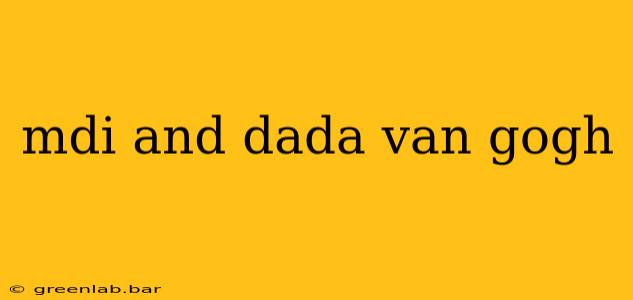Vincent van Gogh, the iconic Post-Impressionist painter, and the Dada movement, a radical artistic rebellion, might seem worlds apart. One, a deeply emotional artist striving for expressive realism; the other, a fiercely anti-art movement challenging established norms. Yet, exploring the interplay between Van Gogh's work and the Dadaist ethos reveals surprising parallels and influences, highlighting the complex evolution of modern art.
The Emotional Intensity: A Shared Ground
While vastly different in approach, both Van Gogh's art and Dada share an undeniable emotional intensity. Van Gogh's canvases, bursting with color and thick impasto, are visceral expressions of his inner turmoil and passionate engagement with the world. His swirling brushstrokes and bold color choices convey a raw, unfiltered emotionality that resonates deeply with viewers. Similarly, Dada, born from the horrors of World War I, channeled the disillusionment, anxiety, and absurdity of the era into provocative and often chaotic artworks. The emotional rawness, the rejection of conventional beauty, and the embrace of visceral expression are common threads connecting these seemingly disparate artistic expressions.
Beyond Representation: A Focus on Process and Emotion
Van Gogh's stylistic choices often prioritized emotional impact over strict adherence to representational accuracy. The distorted perspectives, exaggerated brushwork, and vibrant colors in his paintings weren't meant to perfectly replicate reality but to convey the intensity of his subjective experience. This emphasis on feeling over form finds a strong echo in Dada's embrace of chance, spontaneity, and the anti-aesthetic. Dada artists frequently employed unconventional techniques, utilizing found objects, collage, and performance art to express their rejection of traditional artistic values. Both Van Gogh and the Dadaists prioritized the emotional and experiential aspects of art over its purely representational capabilities.
Dada's Appropriation and Reinterpretation: A Post-Van Gogh Lens
While not directly influenced by Van Gogh in a stylistic sense, Dada's appropriation and reinterpretation of artistic traditions indirectly acknowledge his impact. Dada's embrace of unconventional materials and techniques can be viewed as a radical extension of the expressive freedom exemplified by Van Gogh's bold use of paint and color. The Dadaists' rejection of artistic conventions, their willingness to challenge established norms, and their focus on subjective experience can be seen as a logical, albeit extreme, development of the emotional intensity and expressive freedom pioneered by artists like Van Gogh.
The Anti-Art Gesture and Van Gogh's Legacy
The Dadaist "anti-art" gesture, their deliberate attempt to subvert and critique the very notion of art, might seem to contradict Van Gogh's passionate dedication to his craft. However, both can be interpreted as powerful reactions against societal norms. Van Gogh's struggle for recognition and his outsider status resonate with the Dadaists' rejection of the established art world. His unconventional methods and passionate commitment to his art, despite lack of initial success, could be seen as a precursor to the Dadaists' rebellion against convention and their championing of the unconventional.
Conclusion: Unexpected Resonance
The connection between Van Gogh and Dada isn't one of direct influence but rather a resonance of shared emotional intensity, a rejection of artistic constraints, and a profound engagement with the subjective experience of the artist. Examining their work through this lens reveals an unexpected dialogue between a passionate Post-Impressionist and the radical avant-garde of the early 20th century, highlighting the complex and evolving nature of artistic expression. By exploring these unexpected links, we gain a richer understanding of both Van Gogh's enduring legacy and the revolutionary impact of Dada.

